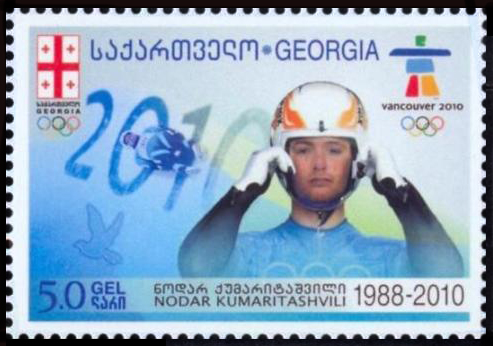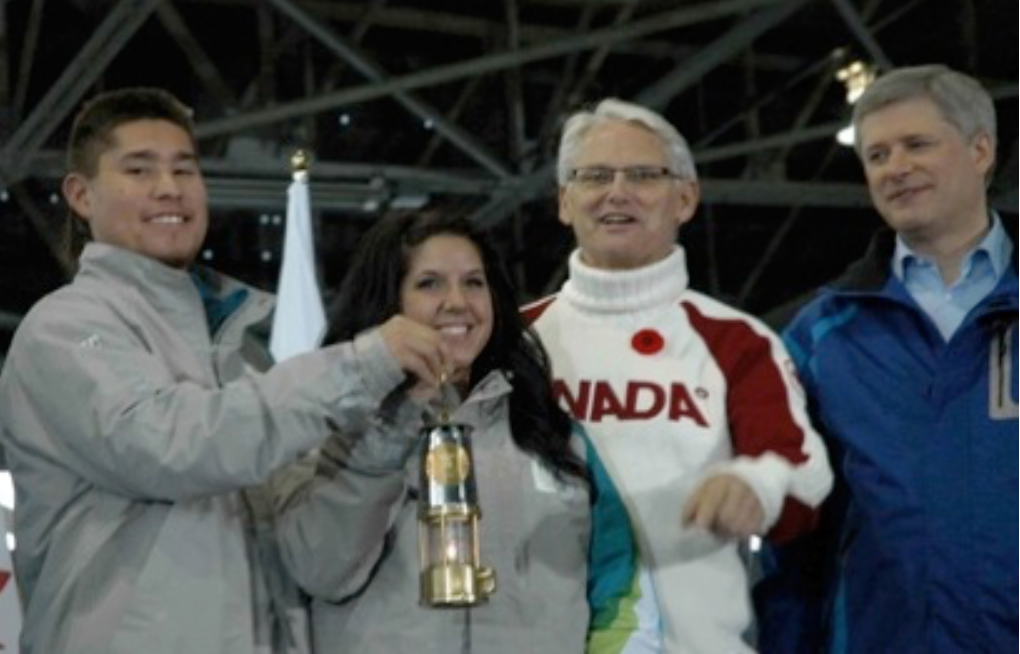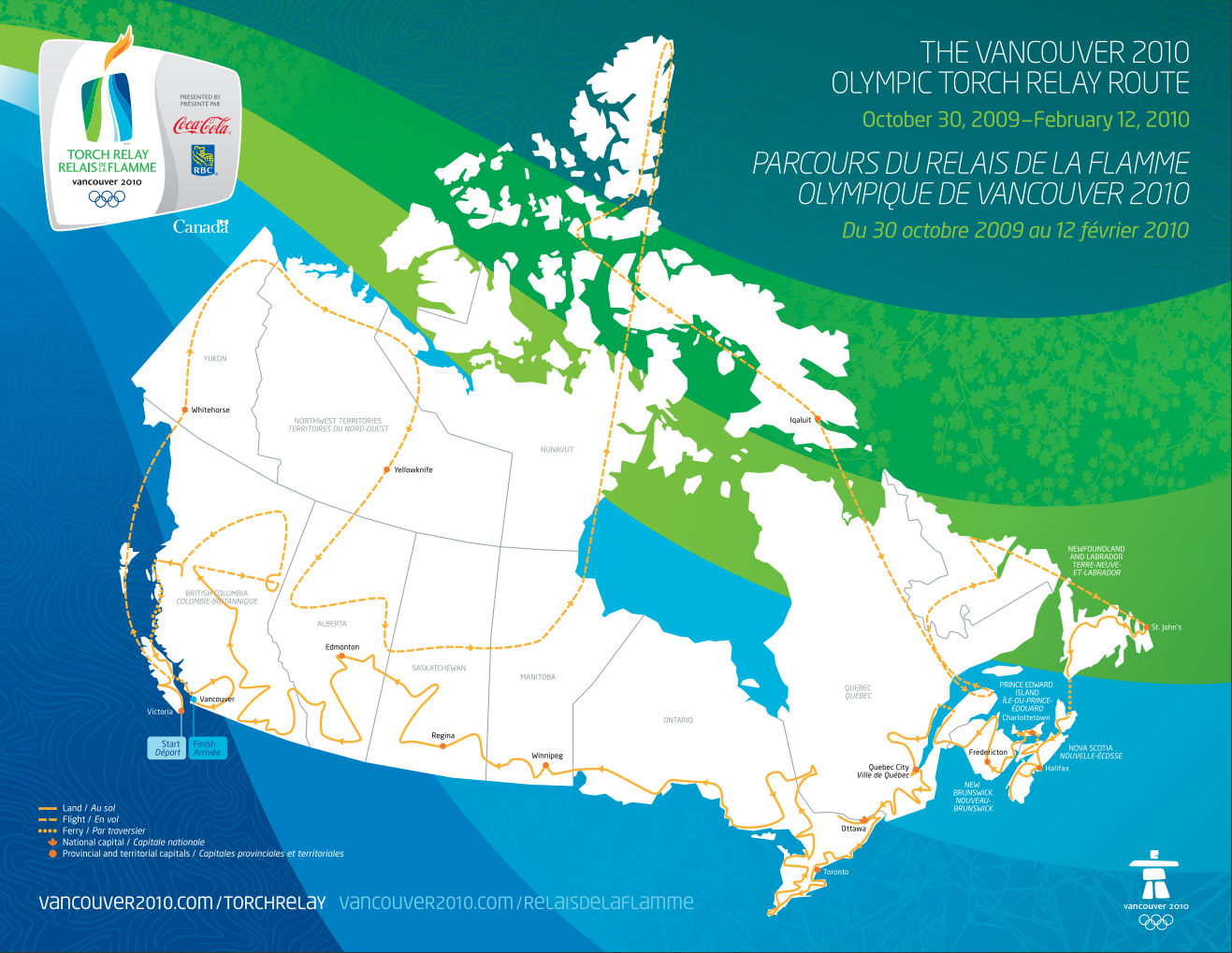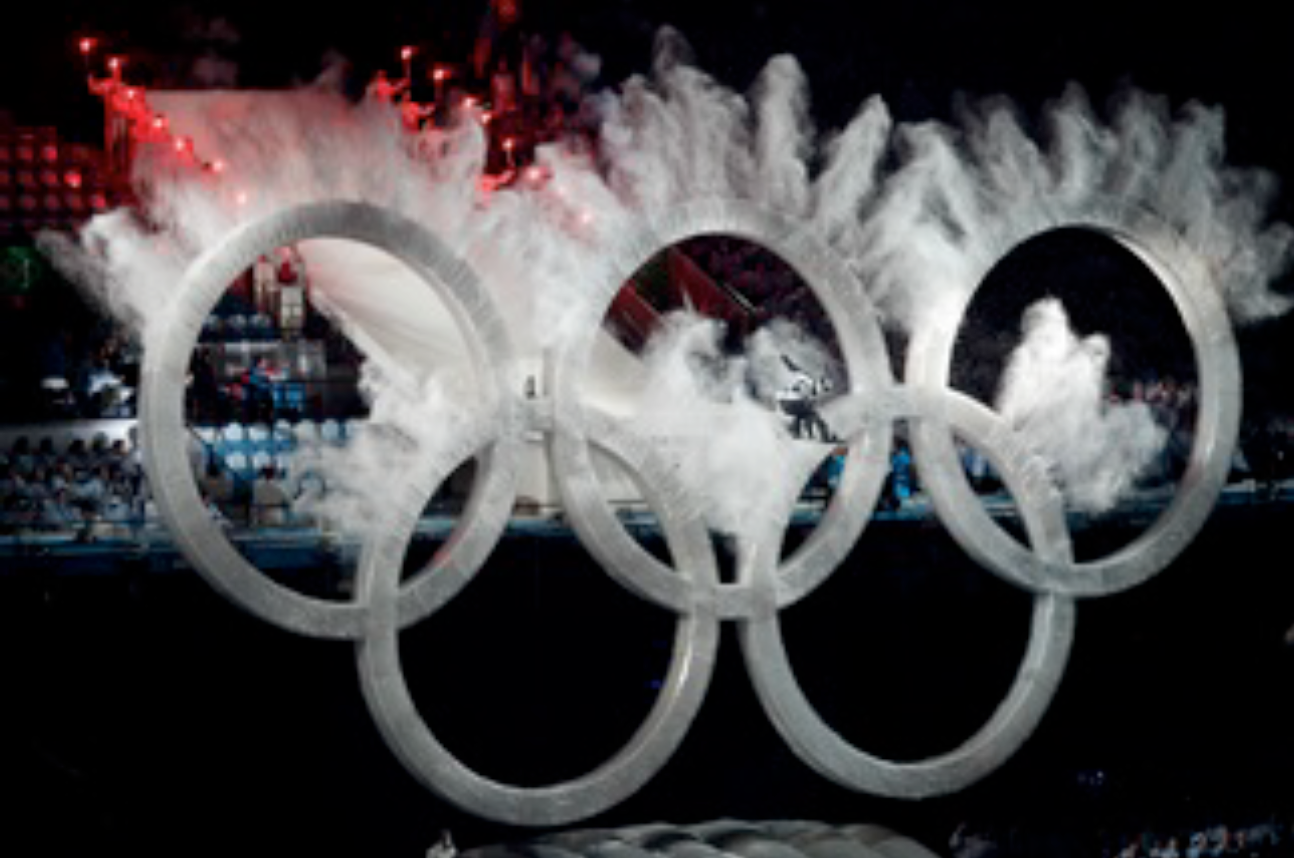
Bob Mackin
All the years of politics and economics, boosterism and booing finally gave way to 17 days and nights of sport and spectacle. It was British Columbia’s time to shine, and Premier Gordon Campbell used the Games for an election-style campaign and to promote the province to international business visitors.
His B.C. Liberal Party had already scored a third consecutive term in May 2009 and the next vote was not scheduled until May 2013. Campbell was intent on resuscitating his sagging popularity after introducing the controversial Harmonized Sales Tax in July 2009. 
Campbell was everywhere, in red mittens and Canadian Olympic Committee garb or in a VANOC workforce blue jacket with a Canada scarf. He had been counting the days until the Games. Literally. His office bathroom on the seventh floor of Canada Place’s World Trade Centre included a 2003 to 2010, Alcan-sponsored Olympic countdown calendar beside campaign posters and newspaper front pages proclaiming his election victories.
Campbell spent the eve of the Games at the exclusive Vancouver Club, which was transformed for the IOC into the Olympic Club, for dinner with GE Energy CEO Alex Urquhart and GE chairman Jeff Immelt. One of the world’s biggest industrial conglomerates owned Olympic broadcaster NBC and was nearing completion of a controversial $663 million hydroelectric plant on the Toba River up the coast from Vancouver. GE and local partner Plutonic Power would sell electricity through builder Peter Kiewit, which expanded the Sea-to-Sky Highway, to B.C. Hydro, the government’s power utility. (Campbell also paid GE Olympic sponsorship president Peter Foss and NBC Olympics president Dick Ebersol a visit on February 27, the eve of the closing ceremony, and hosted the company’s reception in the provincial party room on the fourth floor of the Vancouver Art Gallery.)
As the Olympic torch relay re-entered Vancouver via the Lions Gate Bridge on February 12, Campbell had already appeared on Grouse Mountain for an interview with NBC’s Today Show and returned downtown to greet California Governor Arnold Schwarzenegger at the newly opened, $450 million Fairmont Pacific Rim hotel across from the Vancouver Convention Centre.
The former steroid-enhanced bodybuilder and action movie star took his turn in the torch relay through Stanley Park. Elected officials or declared political candidates were not supposed to be torchbearers, but VANOC bent its rules so Schwarzenegger could pass the Olympic flame to Sebastian Coe, the Moscow 1980 and Los Angeles 1984 1,500-metre champion and chairman of the London 2012 Summer Olympics, beside the Brockton Point lighthouse. Campbell stood clapping and smiling, like a proud father, as the sun rose on opening day.
Ominous, grey clouds were approaching. The weather and the mood were changing.
Ski jumpers were the only athletes who competed February 12. The rest eked out one more training session and most planned to march in the evening’s opening ceremony with teammates.
At the Whistler Sliding Centre, luger Nodar Kumaritashvili of Bakuriani, Georgia, flipped the transparent visor on his helmet over his face and put his gloved hands on the handles next to his sled near the top of the $105 million track.

Georgian postage stamp in memory of Nodar Kumaritashvili.
Kumaritashvili had spoken the night before by phone with his father David, a national youth luge champion when Georgia was in the Soviet Union. The 21-year-old feared the newest Olympic track, which was unlike any he had plied. It was fast, long and narrow, on a steep slope between two valleys, just 92 metres at its widest. At Utah Olympic Park, the 2002 track was 450 m wide.
When it was finished in 2007, veteran Canadian bobsled pilot Pierre Lueders, a Nagano 1998 gold medallist and two-time world champion, and brakeman Justin Kripps, a Hawaii-born, Okanagan-raised former sprinter, took the first slide six days before Christmas. Their sled took air because of an ice ridge near the end of the first run. Luckily, the duo didn’t crash or flip.
The complex was originally envisioned for Grouse Mountain by Arthur Griffiths and his domestic bid committee. Planners considered the Callaghan Valley nordic centre before finally settling on the site at Blackcomb Mountain. The best chance for post-Games revenue generation, whether it be competitions, athlete training or tourist visits, would be at a location that could be accessed by car or chairlift from the cluster of hotels at the resort village.
Kumaritashvili’s name was called on the public address system. He wore the number 30 bib. It was just before 10:50 a.m. The start tones sounded. He grabbed the two bars next to his sled and propelled himself forward, reclining on the sled with his legs in the runners. He would use a combination of leg, shoulder and head movements to steer the fibreglass sled while it hurtled down the icy course.
Kumaritashvili had learned to slide as a child in Bakuriani, but there was no suitable track near his hometown. He had to travel all the way to Latvia to train. With a limited budget, the Georgians could not afford to compete in the February 2009 test event at Whistler, but Kumaritashvili came and took 20 runs at the November 2009 international training week. Werner Hoeger, who competed for Venezuela, suffered a concussion on a crash during those sessions and was among several lugers who complained that Canadian athletes were given more practice runs on the difficult track. Officials scheduled extra sessions in January 2010, but the Georgians weren’t there.
It seemed like everything was normal for the world’s 44th-ranked luger through the section called Gold Rush Trail until turn 15. The last curve, called Thunderbird, saw Kumaritashvili hit 144 kilometres per hour. He was not the first to break the 137 km-h designed speed on the track, but he would be the last to start from the planned position.
Kumaritashvili’s sled hit the wall and he lost control, catapulting off the bowing sled. His body flew over a crash barrier that was too short and was propelled back-first into an unpadded steel girder. He suffered blunt force trauma to the base of his skull. Terrance Kosikar, a staff medic at the Whistler Sliding Centre, rushed to Kumaritashvili. B.C. Ambulance Service paramedics joined in, and desperately tried to resuscitate him.
Emergency crews had practiced for a sledding catastrophe the previous June during a scenario at the Justice Institute in New Westminster, B.C. They simulated a bobsled exiting the track and treated actors portraying injured athletes and spectators. Now it was too real.
“He was lying on the back, I see blood start coming out of the ear,” Russian coach Mikhail Zavialov recounted in an interview with the Canadian Broadcasting Corporation’s Fifth Estate. ”I see the left arm was broken, open broken. I see (his) hand was broken and there is no blood coming from (the) open part of the hand. I understand the heart was stopped.”
“There was nothing more that we could do to help bring this kid back,” Kosikar sighed.

Terrance Kosikar (Mackin)
“Mr. Kumaritashvili was transported, pulseless, to the emergency medical clinic at the Olympic Village in Whistler,” wrote coroner Tom Pawlowski, who ruled the death accidental, in a report issued the following October. “Medical intervention efforts were discontinued at 1149 hours.”
Gordon Campbell took a break from meetings and tried calling John Furlong.
“He didn’t get me on the phone, but he left me a voice mail that took me months to delete, where he said, listen, I can only imagine what you feel today, I want you to know I am here for you and I have your back,” Furlong said. “I have never forgotten it, because on that day we needed something so that we could keep on going.”
The RCMP shut down the track and treated it as a crime scene, a standard procedure, until determining otherwise. It reopened for February 13 competitions with the men starting at the women’s start location and women starting in the junior’s location. Safety padding was affixed to the columns and barriers were extended with plywood where Kumaritashvili came to a violent end.
Svein Romstad, the International Luge Federation’s executive director, declared it was athlete error, a stance reinforced in the federation’s April 2010 report.
“With all due respect, no sports mistake is supposed to lead to a death,” Mikheil Saakashvili, the president of Georgia, said at a February 13 Whistler news conference.
Vancouver, it seemed, had a sad tradition of sports mistakes. British Empire Games marathoner Jimmy Peters was dehydrated and nearly died of heat stroke in the midday sun on the last day of the 1954 Games while approaching the finish line with a wide lead. Earlier in the week he had complained that organizers created a course too long and it needed to be shortened.
During the inaugural September 2, 1990, Molson Indy Vancouver auto race, six track workers were injured pushing Ross Bentley’s stalled car out of the chicane near B.C. Place Stadium. Jean Patrick Hein, a 20-year-old from Montreal, was struck by the car driven by Willy T. Ribbs and died later in hospital of head injuries.
Concerns about luge safety were on the minds of VANOC and luge executives five years earlier when a Brazilian luger crashed on the track built for the Turin 2006 Games and wound up with in hospital with a coma. Renato Mizoguchi’s grisly crash spurred officials to order entire sections of the track at Cesana Pariol be dismantled and rebuilt. The February 2005 world cup was postponed to November while the alterations were made.
Despite what happened in Turin, VANOC operated the 2010 Games track without major safety changes, even after it was discovered to be faster than designer Udo Gurgel intended. Veteran American luger Tony Benshoof, who participated in the official testing and approval process, claimed VANOC ignored his safety complaints.
“Our job was to build a venue according to a certain standard and we did our job thoroughly,” John Furlong told CBC’s Bob McKeown in the Fifth Estate’s “Death at the Olympics” exposé. “And, by the way, we had a massive preoccupation with safety and getting it right.”
That wasn’t universally true. A German worker with contractor Nussli had no safety harness and broke an arm when he fell 55 feet after a crane dislodged a platform at the temporary Cypress Mountain snowboarding stadium in October 2009. WorkSafeBC slapped VANOC with a $75,000 fine when a safety officer noticed workers weren’t using ladders while they dismantled the stadium scaffolding in March 2010.
At least 11 percent of athletes in the 2010 Winter Olympics suffered an injury and nearly 7 percent became ill, according to an IOC medical surveillance study.
Of the 2,567 athletes — 1,522 male and 1,045 female — 287 reported injuries while 185 reported sickness. Every fifth injury registered affected the head, neck and cervical spine. There were 20 concussions reported. Nearly two-thirds of illnesses were cold or flu-related.
VANOC spent $27.25 million on medical services (including $12.8 million from the B.C. government) and counted 8,911 “medical encounters” during the Olympic month. Of those, a whopping 860 were keeping dentists at the Vancouver and Whistler Olympic Village polyclinics busy and most were not injuries. Athletes from developing countries sought routine dental work that they couldn’t afford back home.
The 11 athletes and coaches of the Georgian delegation seemed to march in slow motion past the dancing aboriginal youths at the opening ceremony in B.C. Place. There were supposed to be 12.
With black armbands on their right arms and disconsolate faces, they walked around the floor. In every section of the stadium — even in the media tribunes — people stood and applauded. Many wiped tears from their eyes. The ceremony was dedicated in the honour of Kumaritashvili and the Olympic flag was flown at half-mast. Furlong and the IOC president Jacques Rogge looked dressed for a funeral instead of the planned celebration. The show must go on.
“At these Games you now have the added burden to shine and be united around your fallen colleague Nodar,” Furlong said on the stage riser at the west end of the stadium while the world watched. “May you carry his Olympic dream on your shoulders and compete with his spirit in your hearts.”
Three days later, on a sombre Monday morning, a low-key service was held at the First Memorial Funeral Services chapel in East Vancouver. Furlong, VANOC medical chief Dr. Jack Taunton, medical director Dr. Mike Wilkinson and Patrick Hickey, the Irishman who headed the European Olympic Committees, were among the pallbearers who loaded the gold-coloured coffin into the silver hearse.
“People [were] in shock and sorrow. There were no speeches,” Hickey said. “Nobody wanted a speech.”
The atmosphere in the Fairmont Hotel Vancouver’s Pacific Ballroom in the late afternoon on February 12 was mixed as Canada’s Governor-General Michaëlle Jean hosted the traditional pre-opening ceremony reception for heads of state.
Guests were served petit Quebec tourtiere, Alberta beef tenderloin, Nova Scotia lobster tartelette and Nanaimo bars. The local mayors, aboriginal chiefs and provincial premiers hobnobbed with U.S. Vice-President Joe Biden, Russian Deputy Prime Minister Alexander Zhukov and William McKeeva Bush, Premier of the famed Cayman Islands tax haven. Attendees put down their wine glasses and cheese plates briefly at the $32,161.50 reception for a moment of silence in tribute to Kumaritashvili.

Premier Gordon Campbell and Prime Minister Stephen Harper at Victoria International Airport on Oct. 30, 2009 (Bob Mackin)
With 2,000 windswept and rain-drenched protesters clogging the streets, the dignitaries eventually boarded buses that took a circuitous route to B.C. Place. The protesters were all ages and representing all causes, blaming the Games for homelessness, poverty, environmental degradation and public debt. Police geared for a riot held them at bay on the street beside B.C. Place’s Terry Fox Plaza and memorial arch, as confused bus drivers tried to navigate the streets with their loads of dignitaries and sponsors.
The RCMP deployed its entire complement of 456 quick response team members to join the urban domain tactical troop and Vancouver Police riot squad for the occasion.
People were waiting around the world for the 6 p.m. Pacific time start and it wasn’t going to be delayed for the benefit of tardy dignitaries. A bus carrying Premier Gordon Campbell, Darlene Poole, the Four Host First Nations chiefs and Dick Pound got lost in Vancouver’s West End and wound up in a traffic jam near B.C. Place. Campbell got up from his seat and ordered the bus driver to stop and open the door. He led everyone off the bus and marched past the police officers who were warning passengers not to leave the motorcoach for the block-and-a-half walk.
“We walk in the door, we walk upstairs, we get to the ceremonial box and of course we’ve missed the opening of the Olympics,” Campbell said. “Frankly, I’m livid.”
Campbell sat down, shared a laugh with Prime Minister Stephen Harper’s wife Laureen and realized he was probably the only person in the stadium upset he missed the opening. So grin and bear it, Gordon.
“I remembered something that Jack Poole used to say all the time: the Olympics is not about us, it’s about the other guy,” he said. “It’s about the athlete, it’s about the artist, it’s about the the people that make it work, it’s about the volunteers, it’s about the workers.”
They eventually did witness the parade of chart-topping B.C. singers Sarah McLachlan, Bryan Adams, Nelly Furtado and k.d. lang.
They missed the most spectacular moment of the night, right off the top, when a lone snowboarder in a video on the big screen descended snowy peaks and glaciers as the names of all previous Olympic hosts were recited by the public address announcer: “1924 Chamonix, 1928 St. Moritz, 1932 Lake Placid…”
Faster the boarder plied the slopes, through a giant maple leaf formed by people holding red flares, until he magically appeared on the stadium’s level 4. Professional snowboarder Johnny Lyall slid down a ramp and launched himself through the Olympic rings to land on the floor below.
“Welcome to the Vancouver 2010 Olympic Winter Games, Bienvenue!” Lyall proclaimed upon landing the most-seen snowboard jump in history.
Ceremonies producer David Atkins used the flip of a $2 coin at the bottom of the ramp the previous day to choose between Lyall and fellow professional snowboarder Shin Campos to perform the stunt. The “toonie” landed on tails, the polar bear side, giving Lyall the honour.
Kevin Sansalone, the third pro hired for the production, broke four broken ribs and his collarbone on the first day of rehearsals in January. He landed the stunt, but caught his toe edge on the plastic at the end of the ramp at full speed.
He told friends he was involved in a TV commercial production, meanwhile, he secretly practiced the jump 50 times in the dome’s east end zone.

The Vancouver 2010 Winter Olympics torch route (VANOC)
“I just didn’t say anything,” Lyall said. “They told us if the word gets out, we’ll cut this out of the ceremony.”
After the coin flip, Lyall realized he would commit the most-seen athletic maneuver of the Games, by virtue of performing in the most-watched event. Atkins gave the Vancouverite simple advice.
“The best thing is to focus on the jump, dropping in, taking off and landing,” Lyall said. “The whole day I imagined myself dropping in, taking off and landing. That was all I could do to find any comfort in that time.”
Lyall wasn’t the only person who tried a trick in the dome on opening night. A 48-year-old man with a homemade pass gained entry to what was supposed to be a terrorism-proof stadium and came within a dozen rows of the dignitaries box where Biden was seated. The man tried to flee into the concourse, but was grabbed and handed over to Vancouver Police.
The athletes were sequestered earlier in the afternoon next door at GM Place before entering the stadium. Greece, traditionally the first delegation to enter an Olympic ceremony, was led by biathlete Athanassios Tsakiris. Slalom skier Vassilis Dimitriadis, the first torchbearer back in Olympia, would witness what the 55,000 spectators thought would be the end of the relay that he started. Athletes from a record 82 countries, including newcomers Cayman Islands, Colombia, Ghana, Montenegro, Pakistan, Peru and Serbia, paraded among powerhouses U.S., Germany and Russia. Host Canada came last, with speedskater Clara Hughes holding the maple leaf flag in front.
Jean declared the Games open. Rick Hansen overcame a steep ramp that breached local building code regulations to bring the Olympic flame into the stadium. The friend of Terry Fox toured the world in his 1986 and 1987 wheelchair marathon campaign for global accessibility, equality and spinal cord research.
Wayne Gretzky, Steve Nash, Catriona Le May Doan and Nancy Greene Raine were waiting to light their torches and then the indoor cauldron. Four ice poles were supposed to rise from the false floor like the four totem poles did earlier, and rest on each other with a single shaft emerging from the centre.
Exactly two months earlier when the torch relay went through Ottawa, John Furlong had secretly invited Greene Raine, the Canadian Press female athlete of the 20th century and a Conservative senator. She didn’t know who else would be in that final group until their secret rehearsal on February 10.
“The rehearsals went pretty well, we were confident, we knew the torches had only so much gas in them and everything was scripted,” Greene Raine said. “We had earphones in our ear and we were taking directions from David Atkins. He was so calm.”

Snowboarder Johnny Lyall at the Vancouver 2010 opening ceremony (Brian Howell)
Three of the shafts emerged and so did the centre burner. But not the one nearest Le May Doan. “Athletes, hold your position, we have a glitch,” Atkins said. “We’re having trouble with Catriona’s leg coming up.”
“We stood there for what seemed like an eternity, we could hear him saying ‘try this, try that’ to all the people in behind, underneath the stage,” Greene Raine said.
“Catriona your leg’s not coming up, your role now is to salute the VIP box,” Atkins said. “Everybody else, in 10 seconds I’ll count you down and carry on.”
“Then we did,” said Greene Raine. “When we walked off there wasn’t 20 seconds left of gas.”
Gretzky worked overtime. He was shuffled out of the stadium and into a waiting white pickup truck with green and blue trim for the drive to Jack Poole Plaza while holding the last, lit torch. The giant, white box beside the Vancouver Convention Centre had been removed, revealing the permanent replica of the indoor cauldron that Gordon Campbell failed to keep secret.
Despite what Furlong said the previous day, Gretzky was the last torchbearer.
Games on!
Support theBreaker.news for as low as $2 a month on Patreon. Find out how. Click here.











